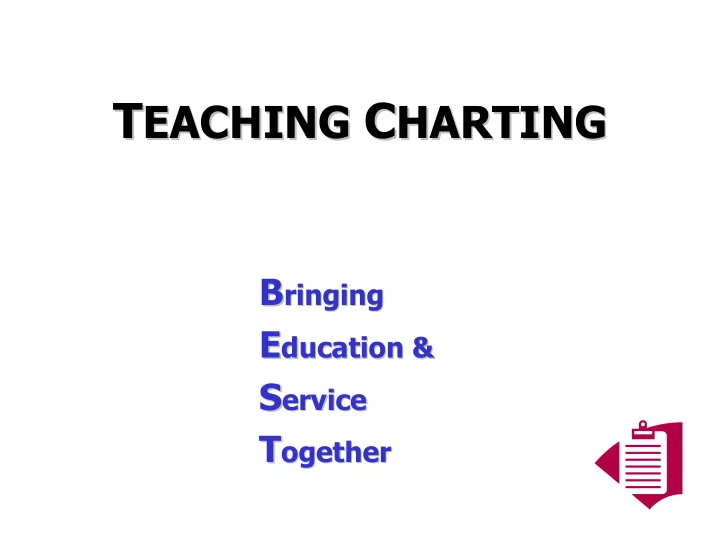

T EACHING C HARTING T EACHING C HARTING B ringing B ringing E ducation & E ducation & S ervice S ervice T ogether T ogether
Learning Objective Learning Objective After participating in this session, participating residents will be able to give a medical student constructive feedback about charting.
Benefits of Benefits of Teaching Charting Teaching Charting Many medical students prefer to Many medical students prefer to learn “hands on” clinical skills learn “hands on” clinical skills (history-taking, physical examination, charting, procedures) from resident from resident physicians rather than from faculty. 1 physicians rather than from faculty 1. Morrison EH, Hollingshead J, Hubbell FA, Hitchcock MA, Rucker L, Prislin MD. Reach out and teach someone: generalist residents’ needs for teaching skills development. Family Medicine (in press).
Benefits of Benefits of Teaching Charting Teaching Charting • Medical school provides numerous teachable moments for students to teachable moments learn writing skills. • Once students become residents, they may be offered less feedback about charting, or they may be less inclined to use feedback that they are offered.
The “CHART” Approach to The “CHART” Approach to Feedback on Written Work Feedback on Written Work Comments C Help H Assessment A Resources R Timing of follow-up T
C OMMENTS C OMMENTS • Before meeting, read the learner’s note and write comments on it. • Include an adequate (but not overwhelming) level of detail. • Writing down your comments will help organize your feedback and will later aid learner’s recall.
H ELP H ELP • Establish mutual goals for this feedback session (learner’s, yours). • Clarify that you will focus on charting , not on clinical issues. • Which writing skills may require extra help ?
A SSESSMENT A SSESSMENT • Discuss your mutual assessment of the written work. • Start with the learner’s self-assessment . • Then give your assessment , balancing positive and negative attributes. • Organize your feedback into logical sections to make it easier to follow. • Involve the learner actively: can s/he learn from rewriting some text with you?
R ESOURCES R ESOURCES • Discuss learning resources to improve charting skills: • Texts • Online resources • Other teachers • Which resources does the learner think would be best for his or her learning style?
T IMING T IMING OF FOLLOW OF FOLLOW- -UP UP When would the learner like to meet again to go over more written work?
Recommend
More recommend